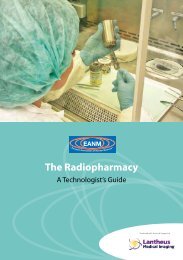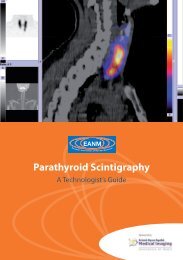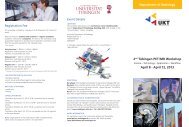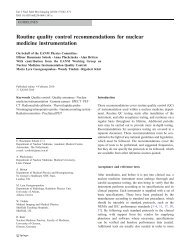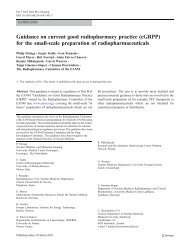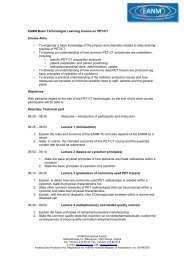Parathyroid Scintigraphy - European Association of Nuclear Medicine
Parathyroid Scintigraphy - European Association of Nuclear Medicine
Parathyroid Scintigraphy - European Association of Nuclear Medicine
Create successful ePaper yourself
Turn your PDF publications into a flip-book with our unique Google optimized e-Paper software.
the operation, the time necessary for frozen<br />
section examination can be used by the surgeon<br />
for inspection <strong>of</strong> the other parathyroid<br />
glands, also reducing surgeon anxiety.<br />
Important points to know when proceeding<br />
with parathyroid imaging<br />
• Imaging is not for diagnosis. The increase<br />
in plasma levels <strong>of</strong> calcium (normal value<br />
88–105 mg/l) and PTH (normal value 10–58<br />
ng/l) establishes the diagnosis.<br />
•<br />
•<br />
•<br />
•<br />
•<br />
Imaging does not identify normal parathyroid<br />
glands, which are too small (20–50 mg)<br />
to be seen.<br />
Imaging should detect abnormal parathyroid(s)<br />
and indicate the approximate size<br />
and the precise relationship to the thyroid<br />
(the level <strong>of</strong> the thyroid at which the parathyroid<br />
lesion is seen on the anterior view;<br />
and whether it is proximal to the thyroid or<br />
deeper in the neck on the lateral or oblique<br />
view or SPECT) (Fig. 1).<br />
Imaging should identify ectopic glands (add<br />
SPECT in cases <strong>of</strong> a mediastinal focus, and<br />
ask for additional CT or MRI for confirmation<br />
and anatomical landmarks) (Fig. 2).<br />
Imaging should be able to differentiate patients<br />
with a single adenoma from those<br />
with MGD (Fig. 3).<br />
Imaging should identify thyroid nodules<br />
that may require concurrent surgical resection.<br />
The choice <strong>of</strong> imaging technique<br />
The most common preoperative localisation<br />
methods are radionuclide scintigraphy and<br />
ultrasound. As stated before, the two main<br />
reasons for failed surgery are ectopic glands<br />
and undetected MGD (Levin and Clark 1989).<br />
Because high-resolution ultrasound would,<br />
even in skilled hands, fail to detect the majority<br />
<strong>of</strong> these cases, it is not optimal for preoperative<br />
imaging as a single technique. In the<br />
study by Haber et al. (2002), ultrasound missed<br />
six <strong>of</strong> eight ectopic glands and five <strong>of</strong> six cases<br />
<strong>of</strong> MGD. Ultrasound may, however, be useful<br />
in combination with 99m Tc-sestamibi imaging<br />
(Rubello et al. 2003).<br />
99m Tc-sestamibi scanning is now considered<br />
the most sensitive imaging technique in patients<br />
with pHPT (Giordano et al. 2001; Mullan<br />
2004). Whatever the protocol used, 99m Tc-sestamibi<br />
scanning will usually meet the requirement<br />
<strong>of</strong> detecting ectopic glands (all eight<br />
were detected in the study by Haber et al.).<br />
With regard to the recognition <strong>of</strong> MGD, however,<br />
the protocol in use will determine the<br />
sensitivity. When 99m Tc-sestamibi is used as a<br />
single tracer with planar imaging at two time<br />
points -- the “dual-phase” (or washout) method<br />
– the sensitivity for primary hyperplasia is very<br />
low (Taillefer et al. 1992; Martin et al. 1996). Better<br />
results can be obtained by adding SPECT.<br />
Subtraction scanning, using either 123 I (Borley












